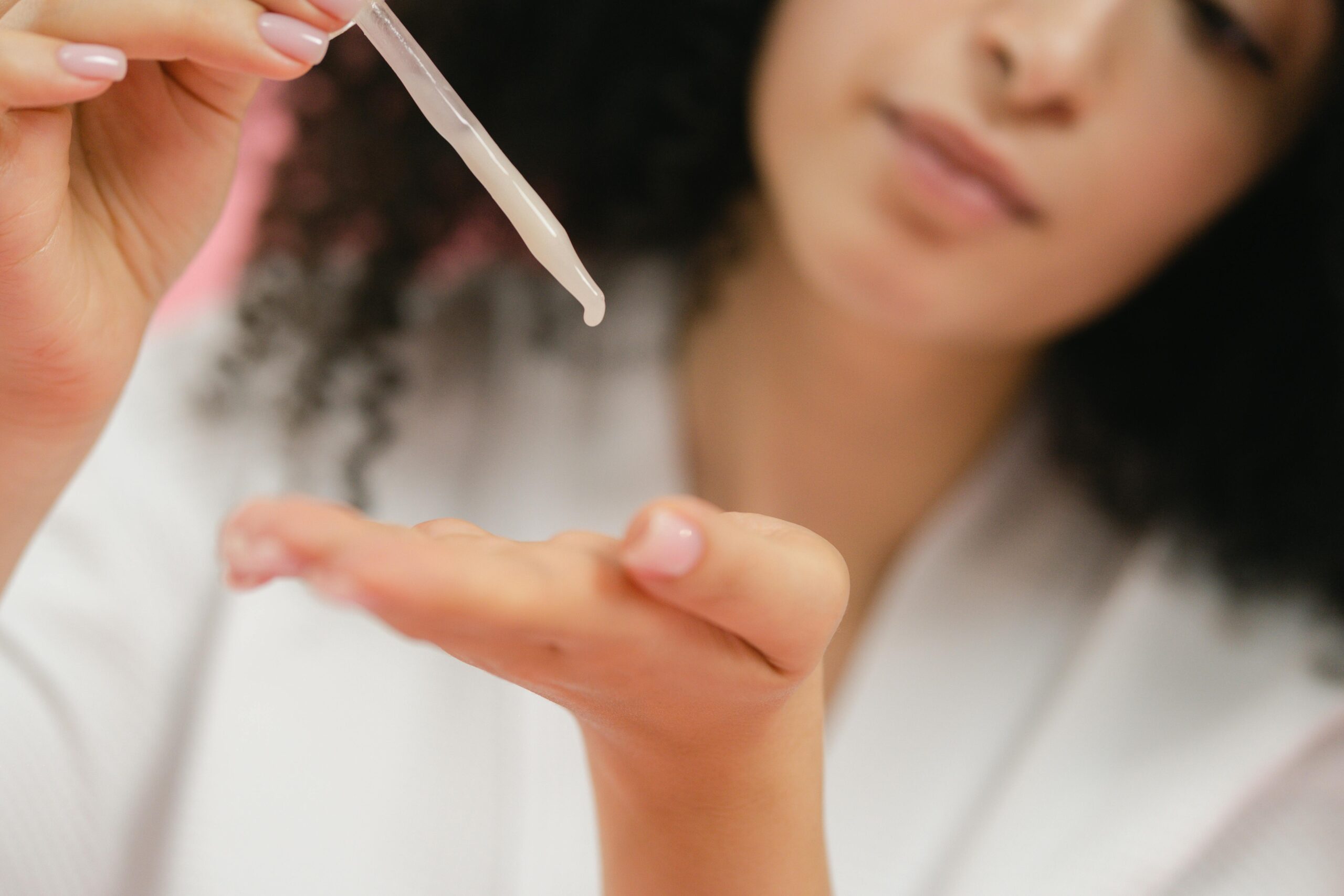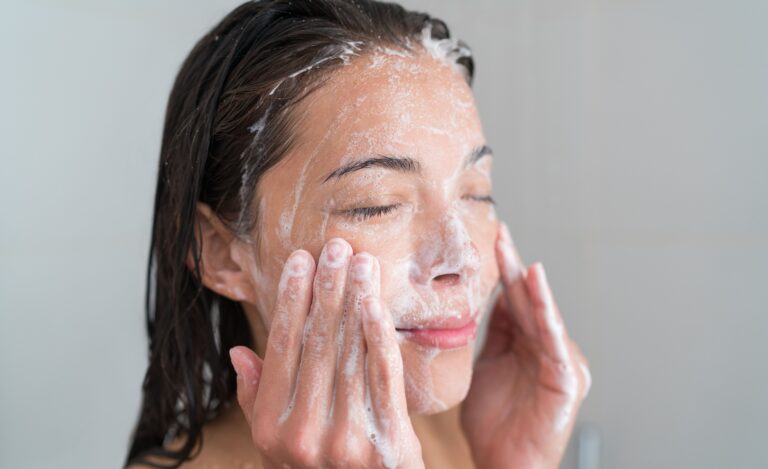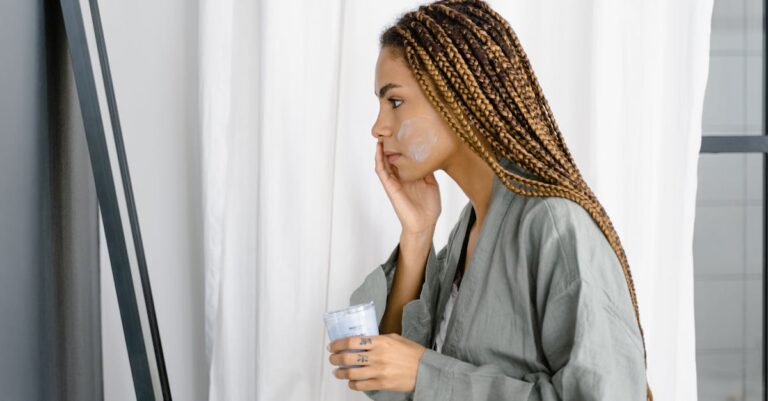Face serums might feel like a modern must-have, but they’ve actually been around since the late 20th century, when cosmetic science began developing lightweight formulas capable of delivering high concentrations of active ingredients. Back then, serums were marketed as luxury treatments, reserved for high-end beauty counters and select consumers.
Their real boom came in the early 2000s, as consumers started to look for faster, more targeted results than traditional creams could provide. Around this time, beauty brands began highlighting star ingredients like vitamin C, hyaluronic acid, and retinol, making serums the go-to solution for visible results.
In 2010, the influence of K-beauty trends further accelerated their rise, with multi-step routines introducing global audiences to the idea of layering serums for different concerns. Social media and online skincare communities amplified this growth, turning serums from niche products into everyday essentials and sparking curiosity among both skincare beginners and enthusiasts.
Then came the COVID-19 pandemic. With more time at home, people invested in self-care and skincare education, often through online tutorials and influencer content. That was the moment when sales of serums spiked as they became symbolic of both self-indulgence and serious skin health.
But the question remains: do serums actually make a difference, or are they just another skincare trend? In this article, we’ll break down what serums are, the science behind their effectiveness, the types available, and how to choose and use them properly—so you can decide if they deserve a spot in your routine.
What Are Face Serums?
Face serums are lightweight, fast-absorbing skincare products formulated to deliver a high concentration of active ingredients into the skin, targeting specific concerns more effectively than many traditional products.
Thanks to their smaller molecular structure and potent formulas, serums can penetrate the skin’s surface layers more efficiently, making them one of the most results-driven steps in a skincare routine.
Serum vs. Other Skincare Products
- Serum vs. Moisturizer: Moisturizers primarily hydrate and seal in moisture by forming a protective barrier on the skin’s surface. Serums, on the other hand, are lightweight treatments that deliver concentrated active ingredients into the skin to directly target concerns like dullness, fine lines, or acne.
- Serum vs. Toner: Toners refresh the skin, balance its pH, and prepare it to absorb the products that follow. Serums are the next step treatment formulas designed to address specific skincare goals.
- Serum vs. Face Oil: Face oils nourish, soften, and strengthen the skin’s barrier, while serums work deeper within the skin’s surface layers to treat underlying issues such as dehydration, pigmentation, or premature aging.
In short, serums are the “treatment step” in a skincare routine. They’re not meant to replace moisturizers or other products, but to complement them, helping you address specific skin needs more directly.
Benefits of Using Serums
Serums have earned their status in the skincare world for a reason—they pack a high concentration of active ingredients in a small package. Here’s why incorporating serums into your routine can seriously level up your skincare game:
High Potency
Because they don’t contain as many fillers or emollients as moisturizers, serums can hold a higher percentage of active ingredients—like Vitamin C, hyaluronic acid, or retinol—making them more effective than many other skincare products at delivering noticeable improvements with only a few drops per application.
Quick Absorption
Serums are made to absorb rapidly into the skin, delivering benefits without leaving a heavy or greasy residue. This makes them ideal for layering with other skincare products.
Targeted Action
Serums are designed to focus on specific skin issues like wrinkles, dark spots, dehydration, acne, or redness. Their high concentration of actives means you get results faster and more effectively compared to general-purpose products.
Suitable for All Skin Types
There’s a serum for everyone, whether your skin is dry, oily, sensitive, or a little bit of everything. You can find calming serums for reactive skin, exfoliating ones for dullness, or hydrating versions for dry patches.
Enhances Overall Skincare Routine
Using a serum doesn’t replace your cleanser or moisturizer—it enhances what they do. By addressing underlying concerns, serums work in tandem with other products to promote healthier, more balanced skin over time.
Boosts Skin’s Long-Term Health
While some serums provide near-instant glow or hydration, the real magic happens over weeks of consistent use. Many serums help stimulate collagen, regulate oil production, or reduce pigmentation, contributing to long-term improvements in skin texture and tone.
In short, serums are one of the most efficient ways to give your skin exactly what it needs, right when it needs it.
Types of Face Serums and Their Active Ingredients
Not all serums are created equal—and that’s the beauty of them. Depending on their active ingredients, base, texture, and delivery system, each serum is designed to target specific skin concerns. To help you figure out which one belongs in your routine, let’s break them down into key categories:
1. By Active Ingredients
Hydrating Serums
- Purpose: To provide deep hydration and boost moisture levels in the skin.
- Key Ingredients: Hyaluronic acid, Glycerin, Aloe Vera, Panthenol.
- Best For: Dry, dehydrated, or tight-feeling skin (if your skin feels papery after washing or makeup looks flaky, this is for you).
- Benefits:
- Intense Hydration: Hyaluronic acid can hold up to 1,000 times its weight in water, deeply hydrating the skin.
- Plump Skin: Hydrating serums help to plump the skin, reducing the appearance of fine lines and wrinkles.
- Improved Skin Barrier: Enhanced moisture levels support a healthy skin barrier, protecting against environmental aggressors.
Barrier Repair Serums
- Purpose: To restore and strengthen the skin’s natural protective barrier.
- Key Ingredients: Ceramides, Centella asiatica (Cica), Panthenol, Green Tea, Aloe Vera.
- Best For: Sensitive, irritated, or compromised skin (if your skin stings easily, gets red after exfoliation, or feels raw after sun exposure).
- Benefits:
- Soothes Irritation: Cica, aloe vera, and panthenol reduce redness and calm sensitivity.
- Rebuilds Skin Barrier: Ceramides replenish essential lipids, reinforcing the skin’s defense.
- Protects Against Stressors: Green tea provides antioxidant protection against pollution and UV damage.
- Supports Healing: Ideal after sun exposure, exfoliation, or active treatments to help the skin recover.
Brightening Serums
- Purpose: To even out skin tone and enhance radiance.
- Key Ingredients: Vitamin C, Niacinamide, Licorice Extract, Kojic Acid, Alpha Arbutin.
- Best For: Dull or uneven skin tone (if your skin looks tired, or you notice lingering acne marks or sunspots).
- Benefits:
- Evens Skin Tone: Niacinamide helps to even out skin tone and reduce redness.
- Fades Dark Spots: Ingredients like vitamin C and alpha arbutin help to reduce hyperpigmentation, dark spots, and post-acne marks.
- Boosts Radiance: Brightening serums enhance overall skin radiance and glow.
Anti-Aging Serums
- Purpose: To combat signs of aging like fine lines, wrinkles, and loss of elasticity.
- Key Ingredients: Retinol, Peptides, Coenzyme Q10, Antioxidants, Bakuchiol.
- Best For: Mature or aging skin (if you’re starting to see crow’s feet, fine lines on the forehead, or sagging around the jaw).
- Benefits:
- Stimulates Collagen Production: Retinol and peptides promote collagen synthesis, improving skin firmness and elasticity.
- Reduces Wrinkles: Regular use of anti-aging serums can diminish the appearance of fine lines and wrinkles.
Acne-Fighting Serums
- Purpose: To treat breakouts, unclog pores, and regulate excess oil.
- Key Ingredients: Salicylic Acid, Niacinamide, Zinc, Tea Tree Oil.
- Best For: Oily or acne-prone skin (if you struggle with frequent breakouts, blackheads, or shiny skin by midday).
- Benefits:
- Clears Pores: Salicylic acid penetrates deep into pores to dissolve excess oil and debris.
- Reduces Inflammation: Niacinamide and tea tree oil calm redness and soothe irritated breakouts.
- Regulates Sebum: Zinc helps balance oil production to prevent new breakouts.
- Minimizes Post-Acne Marks: Niacinamide can also fade dark spots left by acne.
Exfoliating Serums
- Purpose: To promote cell turnover and reveal smoother skin, and boost radiance.
- Key Ingredients: AHAs (glycolic, lactic), BHAs (salicylic), PHAs.
- Best For: Rough, uneven, or congested skin (if your skin feels bumpy, looks dull, or your pores seem enlarged).
- Benefits:
- Smooths Texture: AHAs and BHAs help to exfoliate the skin, smoothing out rough texture.
- Unclogs Pores: Exfoliating serums can help to clear out clogged pores, reducing the occurrence of acne.
- Brightens Complexion: Regular exfoliation can enhance skin brightness and clarity.
2. By Base
Water-based serums
- Characteristics: Lightweight and fast-absorbing, making them ideal for layering with other products. They’re commonly used in hydrating, brightening, or acne-fighting formulas.
- Best suited for: All skin types, especially oily, combination, or acne-prone skin.
- Why it matters: Absorbs quickly without leaving a greasy residue, perfect for layering multiple treatments.
Oil-based serums
- Characteristics: Richer texture that locks in moisture and deeply nourishes the skin.
- Best suited for: dry or mature skin types, often applied as a finishing step at night.
- Why it matters: Provides long-lasting hydration and helps seal in other skincare products, ideal for very dry or aging skin.
Emulsion (hybrid) serums
- Characteristics: A balanced mix of water and oil, similar to a lotion-serum.
- Best suited for: Normal to dry skin types, or anyone looking for a middle ground between light and rich textures.
- Why it matters: Combines hydration and nourishment, suitable for versatile routines without feeling heavy.
3. By Texture
Gel serums
- Characteristics: Lightweight, cooling, and non-greasy.
- Best suited for: Oily, combination, or sensitive skin.
- Why it matters: Provides hydration and active ingredients without weighing skin down or causing breakouts.
Ampoules
- Characteristics: Highly concentrated treatments designed for short-term or targeted use.
- Best suited for: All skin types, especially when addressing a specific concern quickly.
- Why it matters: Delivers an intensive boost of active ingredients for noticeable results in a short period.
4. By Delivery System
Encapsulated serums
- Characteristics: Protect potent ingredients like retinol or vitamin C in tiny capsules, keeping them stable until is used.
- Best suited for: Sensitive skin or anyone using potent actives who wants to minimize irritation.
- Why it matters: Preserves ingredient potency and reduces irritation risk, ensuring effective results.
Time-release/slow-release serums
- Characteristics: Formulated to release active ingredients gradually over time.
- Best suited for: All skin types using potent actives like retinol or acids.
- Why it matters: Provides consistent results while minimizing the risk of irritation from strong ingredients.
Because each serum is designed with a specific goal in mind, choosing the ones that match your skin’s needs is crucial.
Choosing the Right Serum for Your Skin Type
Not every serum is right for every face. The best choice depends on your skin type and your main skincare concerns. Here’s a breakdown to help guide you:
1. Know Your Skin Type
Dry Skin
If your skin feels tight after washing, or if makeup looks patchy or flaky, consider hydrating serums with ingredients like hyaluronic acid, glycerin, squalane, or ceramides. These draw in and lock moisture, easing tightness and flakiness. Pair with a rich moisturizer to prevent water loss.
Oily or Acne-Prone Skin
If your T-zone is shiny by midday, you have frequent breakouts, or clogged pores, look for formulas with niacinamide, salicylic acid, tea tree extract, or zinc. Stick to lightweight, water-based serums to avoid clogging pores.
Combination Skin
If you have a mix of oily and dry areas, often with an oily T-zone (forehead, nose, chin) and drier cheeks, use lightweight, balancing serums.Niacinamide is excellent here, as it regulates oil while keeping skin hydrated. You can also try a multi-serum approach: apply hydrating formulas to dry areas and clarifying ones to oily spots.
Sensitive Skin
If your skin often turns red, stings after exfoliation, or reacts easily to weather or strong products, opt for calming serums with centella asiatica (cica), chamomile, panthenol, green tea, or allantoin. These ingredients soothe irritation and strengthen the skin barrier. Avoid strong acids or high-strength retinol unless introduced gradually, and choose fragrance-free formulas.
Mature Skin
If you have fine lines around the eyes, a sagging jawline, and dullness that doesn’t improve with hydration, consider serums that contain retinol, peptides, and antioxidants (such as vitamin E, coenzyme Q10, or resveratrol). These stimulate collagen production, reduce fine lines, and protect against free radical damage. Start retinol with lower concentrations to minimize sensitivity.
Normal Skin
Balanced and generally low-maintenance. Most serums will work well, so you can choose based on specific concerns you’d like to target, such as brightening or preventative care.
2. Identify Your Skin Concerns
- Dullness or Uneven Tone? Try Vitamin C, alpha arbutin, or licorice extract.
- Fine Lines and Wrinkles? Go with retinol, peptides, or bakuchiol.
- Acne or Congested Pores? Look for salicylic acid, niacinamide, or tea tree oil.
- Dryness or Flaky Skin? Choose hyaluronic acid, squalane, or amino acids.
- Redness or Irritation? Opt for cica (centella), chamomile, or madecassoside.
3. Check Compatibility with Other Products
Not all active ingredients can be combined in the same routine. Mixing the wrong ones can cause irritation, peeling, or even cancel out their benefits. Here’s what to keep in mind:
- Retinol + Vitamin C: Avoid layering them in the same routine. Vitamin C works best in the morning (protecting against free radicals), while retinol is more effective at night (boosting cell turnover). Using them together may cause redness and sensitivity.
- Retinol + AHAs/BHAs: Too harsh when combined in one routine. Both are strong exfoliants, so layering can lead to over-exfoliation, dryness, and irritation.
- Multiple acids (AHAs + BHAs): Stick to one at a time. Overloading with exfoliating acids increases the risk of burning or sensitizing your skin barrier.
- Niacinamide + Vitamin C: Once thought incompatible, newer formulations often stabilize the two. However, if your skin is sensitive, patch test first to ensure no irritation.
4. Start Slow and Observe
Patch Test First:Before applying a new serum to your entire face, test it on a small area (like your wrist or jawline) for a couple of days to check for sensitivity.
Introduce only one new serum at a time: Give your skin 2–4 weeks to see how your skin reacts before adding another. This way, if irritation occurs, it’s easier to identify the cause.
Choosing the right serum means focusing less on trends and more on what your skin actually needs.
How to Use Face Serums
Knowing how to use a serum properly is just as important as choosing the right one. Timing, application method, and layering can all make a big difference in how effective your serum is.
Where Serums Fit in a Skincare Routine?
The general order of application is:
- Cleanser – Start with a gentle cleanser to remove dirt, oil, and makeup. This step prepares your skin to absorb the active ingredients in your serum.
- Toner (optional) – Apply a toner to balance your skin’s pH and remove any remaining impurities. This step also helps to prep your skin for better serum absorption.
- Apply the Serum:
- Use 2–4 drops (a little goes a long way).
- Gently press or pat the serum into your skin using your fingertips.
- Avoid rubbing or tugging—let the serum absorb naturally.
- When layering multiple serums, apply the lightest (watery) textures first and thicker (oil-based) ones last.
- Wait a Moment:Give it 30–60 seconds to fully absorb before moving on to the next step.
- Moisturizer – Lock in the serum’s benefits with a good moisturizer suited to your skin type.
- Sunscreen (morning only) – In the morning, always follow with a broad-spectrum sunscreen to protect against UV damage and prevent worsening of dark spots or aging signs.
Common Mistakes to Avoid
- Using Too Much Product: More isn’t always better. Serums are highly concentrated, so 2–4 drops (or a pea-sized amount) is usually enough. Overusing can waste product, irritate your skin, or cause pilling when layered with other products.
- Skipping Moisturizer or Sunscreen: Serums treat concerns, but they don’t replace moisturizers. Always follow with a moisturizer to lock in the serum’s benefits and prevent water loss. And if you’re using active serums (Vitamin C, retinol, or AHAs), skipping sunscreen in the morning cancels out their benefits and leaves your skin vulnerable to UV damage
- Using the Wrong Serum for Your Skin Type: Just because a serum is trending doesn’t mean it’s right for you. A rich, oil-based serum may overwhelm oily skin, while a lightweight, water-based one may not be enough for very dry skin. Matching formulas to your skin type ensures results instead of setbacks.
Avoiding these mistakes ensures your serum works at its full potential and keeps your skin healthy.
FAQs About Face Serums
Skincare serums can bring up a lot of “what ifs,” especially if you’re new to using them. Here are some of the most common questions—answered simply and clearly.
1. Can I use a serum every day?
Yes—most serums are safe for daily use, but frequency depends on the type:
- Hydrating serums (e.g., HA, glycerin): Safe for daily use, morning and night.
- Exfoliating acids (AHAs/BHAs): 2–3x a week.
- Retinol: Start 2x a week, increase gradually to avoid irritation.
- Brightening serums (e.g., Vitamin C, niacinamide): Apply daily, usually in the morning.
- Acne treatments (e.g., salicylic acid): Once daily or every other day, depending on skin tolerance.
Always listen to your skin and adjust if irritation shows up.
2. Can I use multiple serums at once?
Yes, but with care. Think of serums like building blocks: start gentle and hydrating, then move to brightening, and finally use stronger actives like anti-aging treatments.
1. Hydrating Serums (base layer)
- Examples: Hyaluronic acid, glycerin, panthenol
- Why: These boost hydration and help your skin absorb the next layers more effectively.
2. Brightening Serums (morning only)
- Examples: Vitamin C, niacinamide, licorice root, alpha arbutin
- Why: These target uneven tone and dullness, and pair well with hydration for daytime radiance.
3. Anti-Aging/Repair Serums (night only)
- Examples: Retinol, peptides, growth factors
- Why: These are more potent treatments. They should go on after gentler formulas to minimize irritation.
Extra tips for beginners:
- Pair serums that address different concerns (e.g., hydrating + brightening).
- Avoid layering strong actives together (e.g., retinol + acids, retinol + vitamin C).
- Allow a few seconds between them.
- Apply from thinnest to thickest texture (water-based → gel → oil).
- Limit yourself to 2 serums per routine (e.g., one hydrating + one brightening in the morning, hydrating + retinol at night).
- Always observe how your skin reacts.
3. How long until I see results?
Serums are powerful, but they’re not overnight miracles. The amount of time until you see results depends on the serum and your skin concern:
- Hydration (hyaluronic acid): a few days
- Brightening (Vitamin C, niacinamide): 2–4 weeks
- Acne treatments (salicylic acid, zinc): 1–3 weeks
- Anti-aging (retinol, peptides): 8–12 weeks
Consistency is key. Use serums for at least a few weeks to see noticeable results.
4. Should I use serums in the morning or at night?
It depends on what active ingredients are in the serum.
- Morning: Vitamin C, hydrating serums, and antioxidant serums.
- Night: Retinol, exfoliating acids, or barrier repair serums.
Always follow with sunscreen in the morning.
5. Should I apply serum on damp or dry skin?
Most serums (especially hydrating ones like hyaluronic acid) work best on slightly damp skin. This helps them be absorbed better and lock in moisture. Applying them to dry skin can actually draw moisture out of the skin, leading to dryness.
For stronger actives (like retinol), apply on dry skin to reduce irritation risk.
6. Are expensive serums always better?
Not necessarily. Price often reflects branding or luxury packaging. What matters most are the active ingredients, concentration, and whether the formula suits your skin’s needs.
7. How do I know which serum is right for me?
Start with your skin type and main concern: dryness, acne, aging, sensitivity, or dullness. Then choose a serum with proven ingredients that target that issue:
- Dry → hydrating ingredients (hyaluronic acid, glycerin, ceramides)
- Oily/acne-prone → niacinamide, salicylic acid, zinc
- Sensitive → centella asiatica, panthenol, fragrance-free
- Mature → retinol, peptides, antioxidants
8. What’s the shelf life of a serum?
Typically, 6–12 months after opening. Always check the packaging for a “PAO” symbol (looks like an open jar with a number). Store serums in a cool, dark place and keep them tightly sealed. Vitamin C serums, in particular, can oxidize quickly.
Conclusion
From luxury treatments in the late 20th century to everyday staples in the 2000s, serums have become a cornerstone of modern skincare. Ingredient-focused trends, K-beauty, influencers, and even the pandemic fueled their rise from niche to necessity.
So, do serums actually make a difference—or are they just another skincare trend? The answer lies in how they’re chosen and used. When matched to your skin type and main concern, and applied consistently alongside a proper routine, serums can deliver results that creams or cleansers alone can’t achieve. They’re not a passing fad, but rather a concentrated, targeted tool that reflects how modern skincare has evolved: smarter, more personalized, and more results-driven.
Ultimately, serums aren’t just hype—they’re here to stay. The real difference comes down to finding the right one for you.




